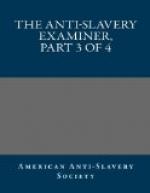Messrs. Daniel and Goodman, New Orleans, in the “N.O. Bee,” Feb. 2, 1838.
“Absconded, mulatto slave Alick, has a large scar over one of his cheeks.”
Jeremiah Woodward, Gonchland, Co. Va. in the “Richmond Va. Whig,” Jan. 30, 1838.
“200 DOLLARS REWARD for Nelson, has a scar on his forehead occasioned by a burn, and one on his lower lip and one about the knee.”
Samuel Rawlins, Gwinet Co. Ga. in the “Columbus Sentinel,” Nov. 29, 1838.
“Ranaway, a negro man and his wife, named Nat and Priscilla, he has a small scar on his left cheek, two stiff fingers on his right hand with a running sore on them; his wife has a scar on her left arm, and one upper tooth out.”
The reader perceives that we have under this head, as under previous ones, given to the testimony of the slaveholders themselves, under their own names, a precedence over that of all other witnesses. We now ask the reader’s attention to the testimonies which follow. They are endorsed by responsible names—men who ’speak what they know, and testify what they have seen’—testimonies which show, that the slaveholders who wrote the preceding advertisements, describing the work of their own hands, in branding with hot irons, maiming, mutilating, cropping, shooting, knocking out the teeth and eyes of their slaves, breaking their bones, &c., have manifested, as far as they have gone in the description, a commendable fidelity to truth.
It is probable that some of the scars and maimings in the preceding advertisements were the result of accidents; and some may be the result of violence inflicted by the slaves upon each other. Without arguing that point, we say, these are the facts; whoever reads and ponders them, will need no argument to convince him, that the proposition which they have been employed to sustain, cannot be shaken. That any considerable portion of them were accidental, is totally improbable, from the nature of the case; and is in most instances disproved by the advertisements themselves. That they have not been produced by assaults of the slaves upon each other, is manifest from the fact, that injuries of that character inflicted by the slaves upon each other, are, as all who are familiar with the habits and condition of slaves well know, exceedingly rare; and of necessity must be so, from the constant action upon them of the strongest dissuasives from such acts that can operate on human nature.
Advertisements similar to the preceding may at any time be gathered by scores from the daily and weekly newspapers of the slave states. Before presenting the reader with further testimony in proof of the proposition at the head of this part of our subject, we remark, that some of the tortures enumerated under this and the preceding heads, are not in all cases inflicted by slaveholders as punishments, but




